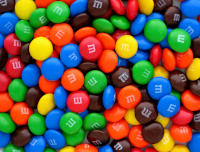
I’d say that photo and a funny text works much better for warning drivers opposed to information about it’s precise dimensions and weight.
For the most charitable reading, that could be a tongue-in-cheek response to someone calling in a large boulder blocking said highway. They arrive and find that the “large” boulder is actually not quite so large.
Is 4 baby elephants less than two grown elephants? And how much is that in football fields?
Nah, I need that in american freedom eagles cubed.
I mean if you say corgi-sized asteroid I can instantly visualize it so that’s good
Not me, not used to corgis. Used to Bernhardiners.
How much corgi is a berhardiner?
Yeah but how heavy are 4 baby elephants? Is it more like one adult sized one or more like two?
As an American, I need this in F-150s. Base model, curb weight.
According to my research, a Ford F-150 is approx. one small adult elephant, or 20 baby elephants. A Fiat 500 is about the same weight as four baby elephants.
as heavy as four baby elephants
If they were on the back of a small tortoise, I believe that’s 1 micro-Pratchett
The late Queen Elizabeth II had her corgis. Coincidence?
Gotta keep nurturing the idiocracy state
To be fair giving measurements in metric to people who don’t normally use it would be more worthless than “corgi sized”.
Murica!!
Just a heads up, i think this was originally an Onion article headline, or from a similar publication.
It’s from the Jerusalem Post.
That’s a terrible paper
True, but it’s not satirical.
How would a “corgi-sized” meteor have a mass comparable to “four baby elephants”?
OK. Assuming the corgi is 60cm long, and assuming with “size” they think of “a sphere with a diameter of”, we get a volume of 113000cm³. Depending on the weight of a baby elephant (90-120kg) we get 360 to 480 kilograms. Divided by the volume, we get a medium density between 3.1 and 4.2 g/cm³. According to Engineering Toolbox, this is about as dense as garnet or aluminium oxide, common types of stone.
If they took the height of the corgi (30cm) as a base of their spheres’ diameter, the volume is down to ~14000cm³, leading to densities between 25.7 and 34.2 g/cm³. Now that would be interesting, because that would even surpass uranium (which has 19.something g/cm³).
So depending on how to interpret those measures, it’ll be a ball of dirt, or a serious nuclear threat. That’s why scientists use metric…
The article is even very specific about this. It’s a Pembroke Welsh Corgi.
For the real numbers:
According to experts from NASA’s Johnson Space Center, the meteor in question was just over 60 centimeters in diameter and weighed half a ton (or around 454 kilograms).
Looks like my estimate is within the parameters.
Uhm I mean God knows what they meant, but in this context I visualize this headline as a meteor with the VOLUME of a Corgi, definitely not a sphere with the diameter of the longest dimension of a Corgi, that doesn’t make much sense to me.
According to experts from NASA’s Johnson Space Center, the meteor in question was just over 60 centimeters in diameter and weighed half a ton (or around 454 kilograms).
https://www.jpost.com/science/article-732223
So, yeah, they meant the diameter. Doesn’t make much sense to me either, but then again, I’m not the one making a living writing science-y articles for a definitely non-science audience.
A corgi has a mass of 10-14kg, so assuming a density of an average mammal of ~1g/cm³ would actually give it a volume of 14000cm³. See paragraph three for results. Not good.
How not good?
That would imply that the meteor was denser than uranium.
Let’s say its made of platinum and iridium… What would happen?
Apart from being too light, it will probably be dense enough so that parts of it will land on the ground. The mass and the (probable) speed will make a decent crater, but for that one would need more data, and a simulation tool.
Wait is there a crater impact simulator tool?
According to experts from NASA’s Johnson Space Center, the meteor in question was just over 60 centimeters in diameter and weighed half a ton (or around 454 kilograms).
This website says this solid bronze corgi dimensions are Height 15" X Width 24" (38.1cm x 60.96) and weight 22lbs (9.979kg).

Reference corgi spotted.
With a can for scale. We just need another photo of a can next to a reference banana for full measurement traceability.
There is no way it is solid and only ~10 kg.
You might be right. I saw another bronze corgi, it was a planter with a semi-hallow center and it said 220lbs. So I’m in unfamiliar territory.
Or maybe this one got the order of magnitude wrong? Imagine showing up to pick up what you expected to comfortably carry on one hand and find something you’d need a cart to safely move without fucking up your back
i just did the math and that’s something around
100,000kg/m3 to 200,000kg/m3400,000kg/m3 to 860,000kg/m3. The densest terrestrial material i could find was Osmium @ 22,610kg/m3. The surface of a neutron star is estimated at 1 billion kg/m3. Our star’s core density is estimated to be 150,000kg/m3. The core of a brown dwarf can be between 10,000kg/m3 and 1,000,000kg/m3 So, uh.edit: forgot there were four elephants
I didn’t do the math and realized that was ridiculous density.
It’s just an extra-large corgi, and some extra-light elephants.
so what like a keeshond or a swedish vallhund? and instead of elephants, rhinocerodes?
From the research other people put on the comments here, I’d say it’s a corgi at about the size of a rottweiler and elephants at around the weight of a human (slightly on the fat side).
ah so a larger than corgi dog and one average statesian. i feel like we need to make an official submission to the bureau of weights and measures
Lol, the US actually publishes average weights in a easy to search format.
Looks like the average USian man weights 90kg, and those elephants were supposed to have 110kg. So, sorry for cheating, but those people need to be more on the fat side than an average USian.
yeah but the average statesian watched too much dragon ball and runs around with 20kg in weighted clothing in case they have to fight a flute.
The added funny part is that the headline came from an article from a metric using country.
Of course there’s a community for that
I like how the text underneath explains exactly what the viewer is intended to notice and laugh at. Thank god
Cue the laugh track!
Baby or adult corgi?












